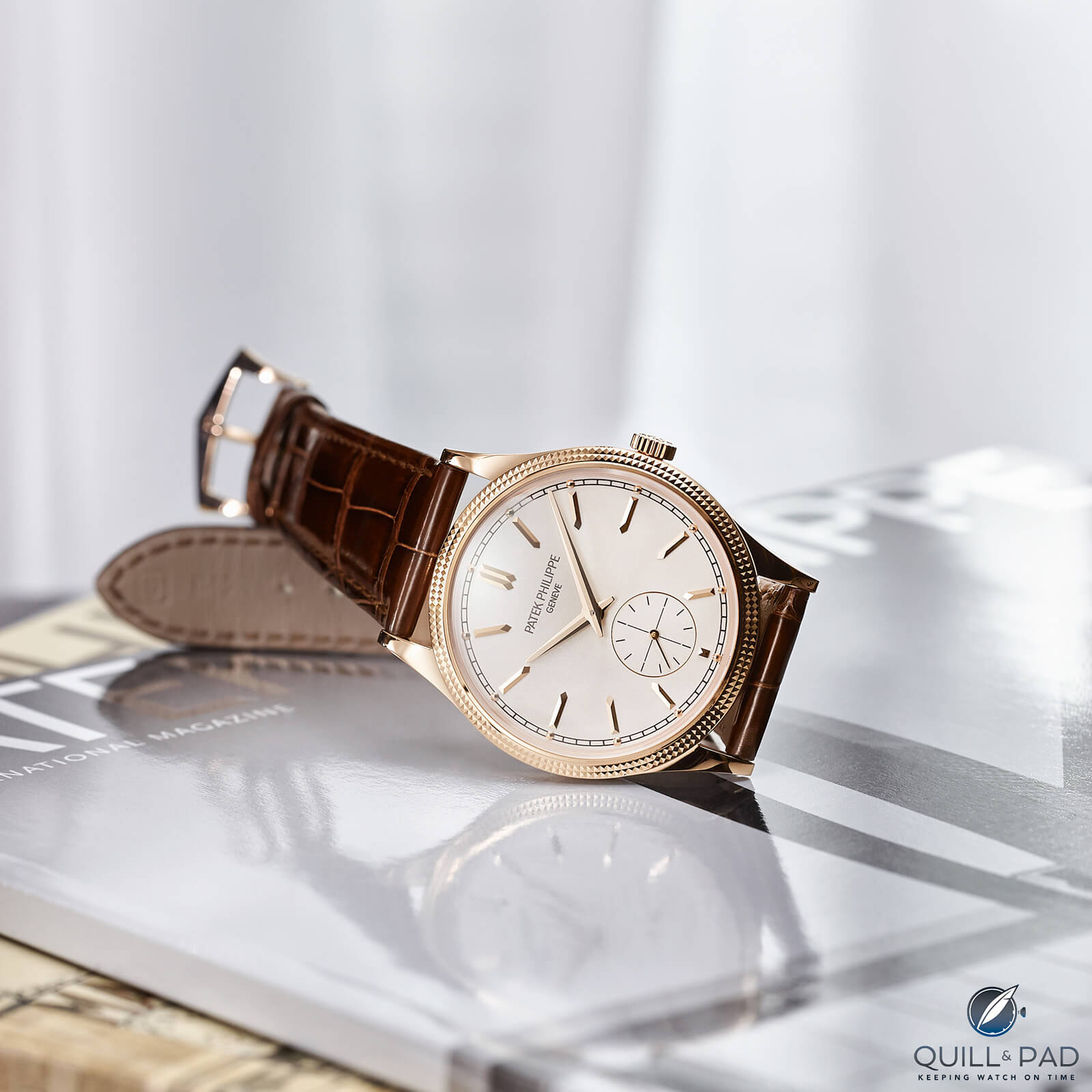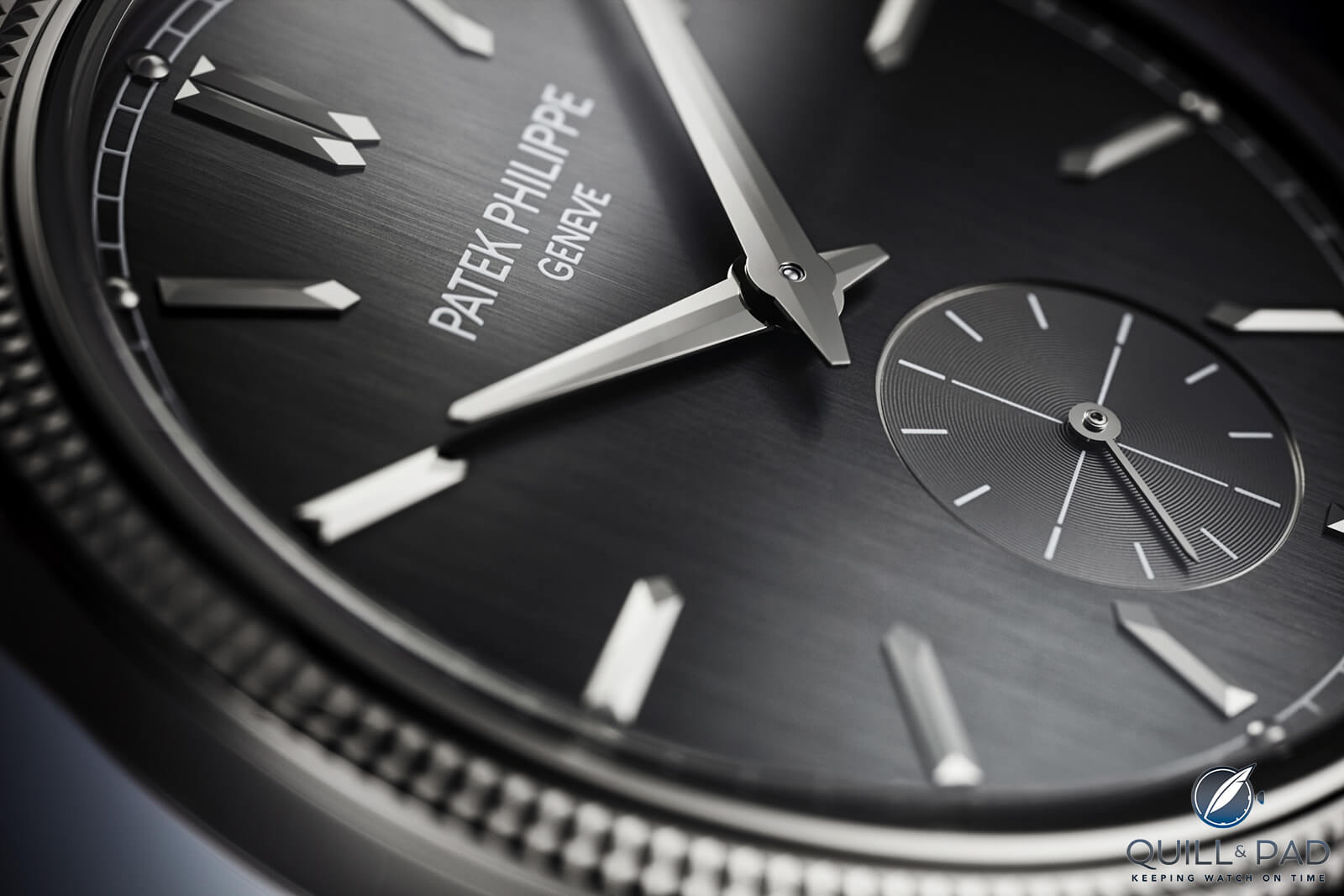by Martin Green
Patek Philippe’s 89-year-old Calatrava collection needs no introduction, but here goes anyway.
The Calatrava launched in 1932 with Reference 96. It was the first Patek Philippe model to receive a reference number, and the first watch released by Jean and Henri Stern upon acquiring the brand earlier same year. The Calatrava quickly became the quintessential dress watch.
Over the following decades the collection expanded, each new model meticulously curated: as Patek Philippe itself has said, the Calatrava collection always needed to be “the most beautiful manifestations of timeless elegance.”
And don’t mistakenly interpret “timeless” to mean “old-fashioned.” Calatravas are created to defy dating.
That doesn’t mean that the design of the watches in this collection is “stuck”; the new Reference 6119 highlights the fact that the Calatrava can successfully both change and remain true to its roots.

Patek Philippe Calatrava Reference 6119R in pink gold
Patek Philippe Calatrava: tour de force design
Designing a new Calatrava may be one of the most difficult tasks a watch designer can be given. As a benchmark model, anything less than perfect is unacceptable. Yet determining what is perfect is nearly impossible.

Dial detail of Patek Philippe’s Calatrava Reference 6119G
On one hand, decades of pedigree must be met, while on the other the design team must use some form of crystal ball. Too much like its predecessors and there will be a disconnect with the current market, which demands something fresh. Too progressive, and the brand is ruled out of touch with its traditional clientele. Especially in an era in when the vast majority of attention is focused on stainless steel sports watches, a brand needs to get changes just right to attract some limelight while not turning off loyal fans.
Patek Philippe did just that with two strokes of Calatrava brilliance. Three if you count the movement.

Crown, lugs, and case band of Patek Philippe’s Calatrava Ref. 6119R in pink gold
The first is going for a bezel with the traditional clous de Paris decoration, a subtle yet distinct pattern of small pyramid shapes made by a traditional guillocheur using a hand-guided tool. Not only does this add a layer of distinctive refinement, but it also follows precedent as the clous de Paris décor (also called hobnail) has an extensive history within the Calatrava collection, including gracing a version of the first Reference 96.
The second stroke of brilliance is found in the bold dial design – bold, but not overly so. Bolder hands and hour markers are kept in check by a more subtle railroad track marking the minutes.

Patek Philippe’s Calatrava Ref. 6119G in white gold
The subdial for seconds at 6 o’clock is classic, but giving it a sector-style layout keeps it from looking old fashioned. The result is a dress watch with broad appeal.
It is interesting to note that Patek Philippe opted for a 21 mm lug width. This is quite substantial given that the case diameter is a very wearable 39 mm.
From a design point of view, this is an essential part of Reference 6119. Most 39 mm watches would have an 18 mm lug width because with anything larger the brand runs the risk of making the watch look smaller than it actually is.

Patek Philippe Calatrava Reference 6119R in pink gold
Patek Philippe achieved the opposite, and that’s thanks to the shape of the lugs, which have been kept elegant and rather slim with clear curvature toward the straps. Visually, this plays a small trick with the mind, making the watch look larger. This is what is so cool about dress watches: fractions of a millimeter can make or break the design.
The heart of the matter: the movement
The aesthetic appeal of dress watches is their subtleness and refinement. This is part of the attraction, but that’s usually not enough for a long and lasting love affair. A good dress watch is like an old-fashioned Gran Turismo, a beautifully styled car that combines a comfortable and luxurious cabin with generous performance.
So for a dress watch, what’s under the hood matters. This is not news to Patek Philippe: this brand wrote the manual on movements many decades ago. Patek Philippe knew that to position Reference 6119 properly, the movement is as important as the exterior design.

Caliber 30-255 PS movement of the Patek Philippe Calatrava Ref. 6119
With the new Caliber 30-255 PS, Patek Philippe launches a thin movement only 2.55 mm in height with a substantial diameter more fitting (no pun intended) for Reference 6119. The 31 mm size gives Patek Philippe enough room to equip it with two parallel mainspring barrels offering a generous power reserve of 65 hours.
The movement leaves very little to be desired, running at a 4 Hz frequency and featuring a Gyromax balance fitted with a Spiromax balance spring, hacking seconds, and compliant with the Patek Philippe Seal.
In terms of movement architecture, Patek Philippe made it look just as forceful as the front of Reference 6119. The large bridges holding the spring barrels make it look potent, while the gear train occupying the top part of the movement adds a dash of elegance.
With a 31 mm movement inside a 39 mm case, Patek Philippe only needed to fill 4 mm around its circumference with a movement holder ring. This is quite a slender rim without becoming too slim and has the added advantage that the movement itself appears larger.
The most important achievement of Reference 6119 is that each element is balanced, not only by itself but also in connection with the others.

Dial detail of the Patek Philippe Calatrava Ref. 6119R
The big question: white gold or pink gold?
This leaves one final question for buyers: white or pink gold? This is quite challenging to answer: the white gold Reference 6119 combines a charcoal-colored dial with a vertical-brushed satin finish and a black leather strap.
Depending on light conditions, the dial can change from nearly black to light grey. The white gold/grey dial configuration can look both formal and casual.

Which one for you? Patek Philippe Calatrava Ref. 6119 in pink gold and white gold
One would expect a similar dial finish on the pink gold version, but there Patek Philippe opted for a grained finish in silver. It is an important detail as it provides a more contemporary touch to the watch, but is also a more fitting finish in relation to the rich look of the pink gold, which it accentuates, but at the same time prevents it from becoming overpowering. The pink gold version is a more classic proposition, and a brown strap is the obvious and (for me) correct choice.
Which one to choose is a matter of personal taste: Patek Philippe gave these two models distinctly different characters. Well-heeled clients might pick both.

Patek Philippe Calatrava Ref. 6119R in pink gold
For more information, please visit www.patek.com/en/company/news/calatrava-clous-de-paris-refs-6119r-6119g.
Quick Facts Patek Philippe Calatrava Reference 6119
Case: 39 x 8.43 mm, white (6119G-001) or pink gold (6119R-001), 30 m water resistance
Movement: manually wound Caliber 30-255 PS with 65-hour power reserve, 2.55 in height, 28,800 vph/4 Hz frequency, Gyromax balance with Spiromax balance spring, Patek Philippe Seal
Functions: hours, minutes, (hacking) seconds
Price: $29,570
* This article was first published 03 May 2021 at Patek Philippe Calatrava Reference 6119: Dressed For Success
You may also enjoy:
Patek Phillipe Calatrava Ref. 6007A: A Very Un-Calatrava Calatrava
Patek Philippe Calatrava Diamond Ribbon Joaillerie Ref. 4978/400G: Swirl Into Infatuation
Calatrava Reference 2508 At Christie’s Patek Philippe 175th Anniversary Auction
My Top 5 Patek Philippe Timepieces Since 2005: A Very Subjective List
The Death Of The Dress Watch: Is It Time To Write Its Obituary?





















































Leave a Reply
Want to join the discussion?Feel free to contribute!